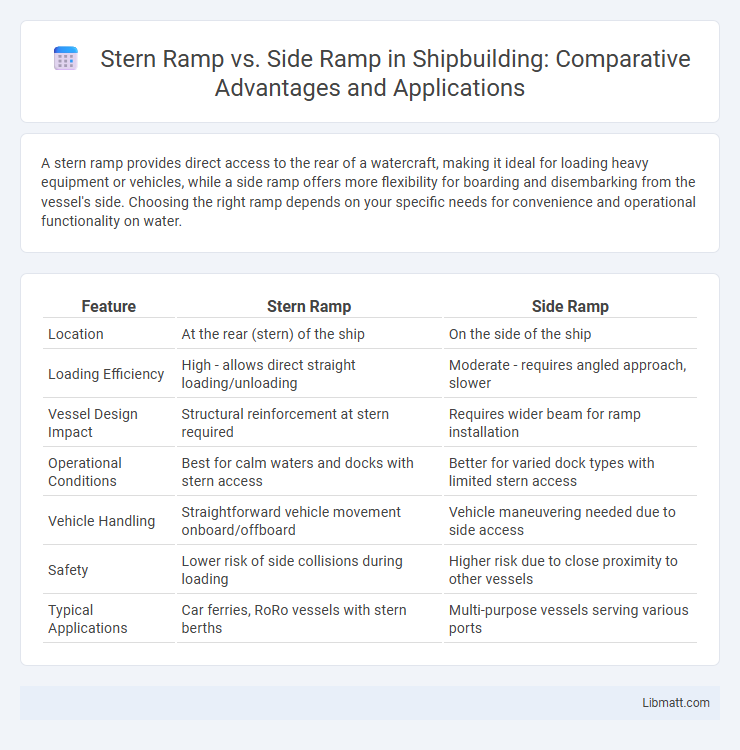A stern ramp provides direct access to the rear of a watercraft, making it ideal for loading heavy equipment or vehicles, while a side ramp offers more flexibility for boarding and disembarking from the vessel's side. Choosing the right ramp depends on your specific needs for convenience and operational functionality on water.
Table of Comparison
| Feature | Stern Ramp | Side Ramp |
|---|---|---|
| Location | At the rear (stern) of the ship | On the side of the ship |
| Loading Efficiency | High - allows direct straight loading/unloading | Moderate - requires angled approach, slower |
| Vessel Design Impact | Structural reinforcement at stern required | Requires wider beam for ramp installation |
| Operational Conditions | Best for calm waters and docks with stern access | Better for varied dock types with limited stern access |
| Vehicle Handling | Straightforward vehicle movement onboard/offboard | Vehicle maneuvering needed due to side access |
| Safety | Lower risk of side collisions during loading | Higher risk due to close proximity to other vessels |
| Typical Applications | Car ferries, RoRo vessels with stern berths | Multi-purpose vessels serving various ports |
Overview of Vehicle Ramps in Marine Vessels
Stern ramps and side ramps serve as critical vehicle access points in marine vessels, facilitating efficient loading and unloading of cargo and passengers. Stern ramps are typically located at the vessel's rear, allowing direct, linear vehicle entry and exit, which is ideal for roll-on/roll-off (RoRo) ferries and larger transport ships. Side ramps, positioned on the vessel's sides, provide versatile access in tight docking situations and enable simultaneous loading and unloading on different parts of the vessel, optimizing turnaround times in busy ports.
What is a Stern Ramp?
A Stern Ramp is a specialized boarding ramp located at the rear (stern) of a boat or ferry, designed to facilitate the easy loading and unloading of vehicles and passengers directly onto a dock or slip. This type of ramp enables smooth access in tight marina spaces, reducing the need for additional dockside infrastructure. Your choice between a stern ramp and a side ramp depends on vessel layout, docking conditions, and operational efficiency.
What is a Side Ramp?
A side ramp is a loading and unloading feature installed on the side of a vehicle or trailer, enabling easier access to the cargo area without needing to use the rear. This design enhances efficiency in tight spaces or crowded environments where rear access is limited. Compared to a stern ramp, a side ramp offers more flexible positioning for forklifts and other equipment, improving operational workflow.
Key Structural Differences
A stern ramp is integrated into the rear of a boat, allowing direct aft access to the water or dock, while a side ramp is positioned on the vessel's side for lateral boarding or loading. The stern ramp typically requires a robust hull reinforcement to handle weight and stress during loading, whereas side ramps demand stronger side supports and enhanced watertight integrity to prevent flooding. Your choice between stern and side ramps should consider these structural differences for optimal performance and safety.
Loading and Unloading Efficiency
Stern ramps offer superior loading and unloading efficiency by allowing vehicles and cargo to be directly aligned with the vessel's centerline, minimizing maneuvering time. Side ramps may require additional positioning and can be less effective in rough sea conditions, potentially slowing down operations. Your choice between stern and side ramps should consider the typical cargo type and dock layout to maximize operational productivity.
Space Utilization and Vessel Design
Stern ramps maximize deck space by allowing vehicles to drive straight on and off, optimizing cargo area layout and facilitating efficient vessel loading and unloading operations. Side ramps require dedicated side access points, which can limit internal space and impose constraints on hull design, potentially reducing overall cargo capacity. Vessel designs incorporating stern ramps often feature wider beams and reinforced transoms to accommodate heavier vehicle traffic and improve stability during loading.
Safety Considerations
Stern ramps typically offer greater stability and a lower angle for safer boarding and disembarking, reducing the risk of slips and falls compared to side ramps. Side ramps may provide easier access in tight marina spaces but often require additional handrails or non-slip surfaces to enhance safety. Your choice should consider the vessel's layout and passenger mobility to minimize accidents and improve overall safety.
Typical Applications and Use Cases
Stern ramps are commonly used on smaller recreational boats and commercial vessels for easy water access during activities like snorkeling, diving, and passenger boarding, allowing smooth entry and exit at the rear of the boat. Side ramps are often found on larger ferries and military landing crafts, designed for rapid loading and unloading of vehicles and cargo in confined docking spaces, optimizing operational efficiency. Your choice between stern and side ramps depends on vessel size, loading requirements, and specific marine operating conditions.
Advantages and Disadvantages
Stern ramps offer superior alignment for larger boats, providing better support and stability during loading and unloading, but they often require more space at the back of the vessel and may limit access to other areas. Side ramps are convenient for smaller boats and allow easier access to the vessel's interior, yet they can be less stable and more challenging to use in rough water or with heavier loads. Your choice depends on boat size, space availability, and loading needs, balancing stability and convenience.
Choosing the Right Ramp for Your Vessel
Choosing the right ramp for your vessel depends on factors like dock layout and vessel type. Stern ramps offer straightforward access for larger boats needing direct rear boarding, while side ramps suit smaller vessels or situations with limited dock space. Assess your docking environment and vessel design to ensure your ramp choice maximizes safety and convenience.
Stern ramp vs side ramp Infographic

 libmatt.com
libmatt.com